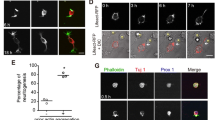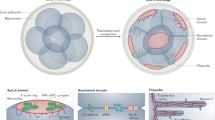Summary
Neural crest cells are motile and mitotic, whereas their neuronal derivatives are terminally post-mitotic and consist of stationary cell body from which processes grow. The present study documents changes in the cytoskeleton that occur during neurogenesis in cultures of avian neural crest cells. The undifferentiated neural crest cells contain dense bundles of actin filaments throughout their cytoplasm, and a splayed array of microtubules attached to the centrosome. In newly differentiating neurons, the actin bundles are disrupted and most of the remaining actin filaments are reorganized into a cortical layer underlying the plasma membrane of the cell body and processes. Microtubules are more abundant in newly-differentiating neurons than in the undifferentiated cells, and individual microtubules can be seen dissociated from the centrosome. Neuron-specific β-III tubulin appears in some crest cells prior to cessation of motility and cell division, and expression increases with total microtubule levels during neurogenesis. To investigate how these early cytoskeletal changes might contribute to alterations in morphology during neurogenesis, we have disrupted the cytoskeleton with pharmacologic agents. Microfilament disruption by cytochalasin immediately arrests the movement of neural crest cells and causes them to round-up, but does not significantly change the morphology of the immature neurons. Microtubule depolymerization by nocodazole slows the movement of undifferentiated cells and causes retraction of processes extended by the immature neurons. These results suggest that changes in the actin and microtubule arrays within neural crest cells govern distinct aspects of their morphogenesis into neurons.
Similar content being viewed by others
References
Altermatt, H. J., Rodriguez, M., Scheithauer, B. W. &Lennon, V. A. (1991) Paraneoplastic anti-purkinje and type I anti-neuronal nuclear autoantibodies bind selectively to central, peripheral, and autonomic nervous system cells.Laboratory Investigation 65, 412–20.
Baas, P. W. (1996) The neuronal centrosome as a generator of microtubules for the axon.Current Topics in Developmental Biology, in press.
Baas, P. W. &Ahmad, F. J. (1993) The transport properties of axonal microtubules establish their polarity orientation.Journal of Cell Biology 120, 1427–37.
Baas, P. W. &Black, M. M. (1990) Individual microtubules in the axon consist of domains that differ in both composition and stability.Journal of Cell Biology 111, 495–509.
Baas, P. W., Pienkowski, T. P., Cimbalnik, K. A., Toyama, K., Bakalis, S., Ahmad, F. J. &Kosik, K. S. (1994) Tau confers drug stability but not cold stability to microtubules in living cells.Journal of Cell Science 107, 135–43.
Banker, G. &Goslin, K. (1991)Culturing Nerve Cells. Cambridge, MA: MIT Press.
Baorto, D. M., Mellado, W. &Shelanski, M. L. (1992) Astrocyte process growth induced by actin breakdown.Journal of Cell Biology 117, 357–67.
Baroffio, A., Dupin, E. &Le Douarin, N. M. (1988) Clone-forming ability and differentiation potential of migratory neural crest cells.Proceedings of the National Academy of Science (USA) 85, 5325–9.
Black, M. M. (1994) Microtubule transport and assembly cooperate to generate the microtubule array of growing axons.Progress in Brain Research 102, 61–77.
Brady, S. T., Tytell, M. &Lasek, R. J. (1994) Axonal transport and axonal tubulin: biochemical evidence for cold-stability.Journal of Cell Biology 99, 1716–24.
Bray, D. (1992)Cell Movements. New York: Garland Publishing Inc.
Bronner-Fraser, M. &Fraser, S. (1989) Developmental potential of avian trunk neural crest cellsin situ.Neuron 3, 755–66.
Burgoyne, R. D. (1991)The Neuronal Cytoskeleton. New York: Wiley-Liss Inc.
Chen, J., Kanai, Y., Cowan, N. J. &Hirokawa, N. (1992) Projection domains of MAP-2 and tau determine spacings between microtubules in dendrites and axons.Nature 360, 674–7.
Cohen, A. M. &Konigsberg, I. R. (1975) A clonal approach to the problem of neural crest determination.Developmental Biology 46, 262–80.
Collins, F. (1978) Axon initiation by ciliary neurons in culture.Developmental Biology 65, 50–7.
Cramer, L. P. &Mitchison, T. J. (1985) Myosin is involved in postmitotic cell spreading.Journal of Cell Biology 131, 179–89.
Dubose, D. A. &Haugland, R. (1993) Comparisons of endothelial cell g- and f-actin distributionin situ andin vitro.Biotechnology and Histochemistry 68, 8–16.
Edson, K., Weisshaar, N. &Matus, A. (1993) Actin depolymerization induces process formation in MAP2-transfected non-neuronal cells.Development 117, 689–700.
Gard, D. L. &Kirschner, M. W. (1985) A polymer dependent increase in the phosphorylation of β-tubulin accompanies differentiation of a mouse neuroblastoma cell line.Journal of Cell Biology 100, 764–74.
Graus, F. &Ferrer, I. (1990) Analysis of a neuronal antigen (Hu) expression in the developing rat brain detected by autoantibodies from patients with paraneoplastic encephalomyelitis.Neuroscience Letters 112, 14–18.
Halfter, W., Chiquet-Ehrismann, R. &Tucker, R. P. (1989) The effect of tenascin and embryonic basal lamina on the behavior and morphology of neural crest cellsin vitro.Developmental Biology 132, 14–25.
Haugland, R. P., You, W., Paragas, V. B., Wells, K. S. &Dubose, D. A. (1994) Simultaneous visualization of g- and f-actin in endothelial cells.Journal of Histochemistry and Cytochemistry 42, 345–50.
Joshi, H. C. &Baas, P. W. (1993) A new perspective on microtubules and axon growth.Journal of Cell Biology 121, 1191–6.
Kanai, Y., Takemura, R., Oshima, T., Mori, H., Ihara, Y., Yanagisawa, M., Masaki, T. &Hirokawa, N. (1989) Expression of multiple tau isoforms and microtubule bundle formation in fibroblasts transfected with a single tau cDNA.Journal of Cell Biology 109, 1173–84.
Knops, J., Kosik, K. S., Lee, G., Pardee, J. D., Cohen-Gould, L. &McConlogue, L. (1991) Overexpression of tau in non-neuronal cells induces long cellular processes.Journal of Cell Biology 114, 725–34.
Leclerc, N., Kosik, K. S., Cowan, N., Pienkowski, T. P. &Baas, P. W. (1993) Process formation in Sf9 Cells induced by the expression of a microtubule-associated protein 2c-like construct.Proceedings of the National Academy of Science (USA) 90, 6223–7.
Le Douarin, N. M. &Smith, J. (1988) Development of the peripheral nervous system from the neural crest.Annual Review of Cell Biology 4, 375–404.
Lee, M. K., Tuttle, J. B., Rebhun, L. I., Cleveland, D. W. &Frankfurter, A. (1990a) The expression and posttranslational modification of a neuron-specific β-tubulin isotype during chick embryogenesis.Cell Motility and Cytoskeleton 17, 118–32.
Lee, M. K., Rebhun, L. I. &Frankfurter, A. (1990b) Posttranslational modification of class III β-tubulin.Proceedings of the National Academy of Science (USA) 87, 7195–9.
Littauer, U. Z., Giveon, D., Thierauf, M., Ginzburg, I. &Postingl, H. (1986) Common and distinct tubulin binding sites for microtubule-associated proteins.Proceedings of the National Academy of Science (USA) 83, 7162–6.
Lu, Q. &Ludueña, R. F. (1994)In vitro analysis of microtubule assembly of isotypically pure tubulin dimers.Journal of Biological Chemistry 269, 2041–7.
Ludueña, R. F. (1993) Are tubulin isotypes functionally significant?Molecular Biology of the Cell 4, 445–57.
Marusich, M. F. &Weston, J. A. (1992) Identification of early neurogenic cells in the neural crest lineage.Developmental Biology 149, 295–306.
Memberg, S. P. &Hall, A. K. (1995) Dividing neuron precursors express neuron-specific tubulin.Journal of Neurobiology 27, 26–43.
Mitchison, T. J. (1992) Actin based motility on retraction fibers in mitotic PtK2 cells.Cell Motility and the Cytoskeleton 22, 135–51.
Panda, D., Miller, H. P., Banerjee, A., Ludueña, R. F. &Wilson, L. (1994) Microtubule dynamicsin vitro are regulated by the tubulin isotype composition.Proceedings of the National Academy of Science (USA) 91, 11358–62.
Pannese, E. (1994)Neurocytology. New York: Thieme Medical Publishers Inc.
Seiber-Blum, M. &Cohen, A. M. (1980) Clonal analysis of quail neural crest cells: they are pleuripotent and differentiatein vitro in the absence of non-crest cells.Developmental Biology 80, 96–106.
Serrano, L., De La Torre, J., Maccioni, R. B. &Avila, J. (1984) Involvement of the carboxy-terminal domain of tubulin in the regulation of its assembly.Proceedings of the National Academy of Science (USA) 81, 5989–93.
Small, J. V. (1981) Organization of actin in the leading edge of cultured cells: influence of osmium tetroxide and dehydration on the ultrastructure of actin meshworks.Journal of Cell Biology 91, 695–705.
Stemple, D. L. &Anderson, D. J. (1993) Lineage diversification of the neural crest:in vitro investigations.Developmental Biology 159, 12–23.
Yamada, K. M., Spooner, B. S. &Wessells, N. K. (1970) Axon growth: roles of microfilaments and microtubules.Proceedings of the National Academy of Science (USA) 66, 1206–12.
Yamada, K. M., Spooner, B. S. &Wessells, N. K. (1971) Ultrastructure and function of growth cones and axons of cultured nerve cells.Proceedings of the National Academy of Science (USA) 49, 614–35.
Yu, W. &Baas, P. W. (1994) Changes in microtubule number and length during axon differentiation.Journal of Neuroscience 14, 2818–29.
Author information
Authors and Affiliations
Rights and permissions
About this article
Cite this article
Haendel, M.A., Bollinger, K.E. & Baas, P.W. Cytoskeletal changes during neurogenesis in cultures of avian neural crest cells. J Neurocytol 25, 289–301 (1996). https://doi.org/10.1007/BF02284803
Received:
Revised:
Accepted:
Issue Date:
DOI: https://doi.org/10.1007/BF02284803




